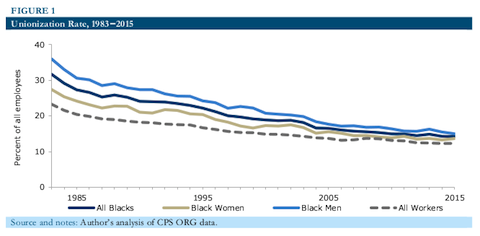Executive Summary
This study uses the most recent Census Bureau data available to examine the trends in unionization for Black workers, focusing on unionization rates as well as the demographic composition of the Black union workforce. This paper also presents data on the impact of unionization on the wages and benefits of Black workers and how these benefits work to reduce racial wage inequality.
Unionization rates have been in decline across the board for decades. Despite this fact, Black workers are still more likely than workers of any other race or ethnicity to be unionized. In 2015, 14.2 percent of Black workers and 12.3 percent of the entire workforce were represented by unions, down from 31.7 percent and 23.3 percent, respectively, in 1983. This large decline in unionization has occurred alongside, and contributed to, an increase in overall wage inequality, as well as the widening Black-white wage gap.
This paper finds that Black union workers of today are very different from Black union workers of the past. In particular, Black union workers today are more likely to be female, older, have more years of formal education, be immigrants, and work in the public sector.
Black union workers also enjoy higher wages, and better access to health insurance and retirement benefits than their non-union peers. These benefits persist even after controlling for systematic differences between the union and non-union workforce. Specifically, Black union workers on average earn 16.4 percent higher wages than non-union Black workers. Black union workers are also 17.4 percentage points more likely than non-union Blacks to have employer-provided health insurance, and 18.3 percentage points more likely to have an employer-sponsored retirement plan.
These benefits are also large for Black workers in low-wage occupations and those with fewer years of formal education. Black union workers in low-wage occupations have wages that are 18.9 percent higher than their non-union counterparts, are 13.1 percentage points more likely to have employer-provided health insurance, and 15.4 percentage points more likely to have employer-sponsored retirement plans. Furthermore, Black union workers with less than a high school degree have a wage advantage of 19.6 percent over their non-union peers, and are 23.4 percentage points and 25.2 percentage points more likely to have health insurance and a retirement plan, respectively.
Some other highlights include:
The percent of Black union workers who are immigrants has more than doubled since 1994: from 7.0 percent in 1994, to 15.4 percent in 2015. Black immigrants are more likely than native Blacks to be unionized. In 2015, Black immigrant workers had a unionization rate of 16.9 percent compared to 13.8 percent for native Blacks. Unionization rates for Black workers have declined across all sectors, but the decline has been especially steep for manufacturing (from 42.3 percent in 1983 to 13.3 percent in 2015). Black union workers on average earn $24.24 per hour, compared to $17.78 for non-union Black workers. 71.4 percent of Black union workers have employer-provided health insurance, compared to 47.7 percent of non-union Black workers. 61.6 percent of Black union members have employer-sponsored retirement plans, compared to 38.2 percent of non-union Black workers.
Introduction
Black workers are more likely than workers of any other race to be unionized.1 This has been true since at least the early 1970s. Blacks are also over-represented in the union workforce, with 14.1 percent of union workers being Black, but only 11.9 percent of the overall workforce being Black. However, the Black unionization rate has been declining throughout this period, as has the overall unionization rate. Given the importance of unions in combating racial wage inequality, the decline of Black worker power through unions presents an obstacle to efforts to reduce inequality.
This report uses Census Bureau data to examine the trends in unionization for Black workers, focusing on unionization rates as well as the demographic composition of the Black union workforce. This paper also presents data on the impact of unionization on the wages and benefits of Black workers and how these benefits work to reduce racial wage inequality.
The data show Black union workers of today look much different from their predecessors of the early 1980s. Black union workers today are more likely to be older, female, foreign-born, have more years of formal education, and work in the public sector.
The data further suggest that unions significantly boost the wages and access to health and retirement benefits of Black workers. Even after taking into account systematic differences among the union and non-union populations, Black union workers have wages that are 16.4 percent higher than their non-union counterparts. The union wage advantage is even more for Black men (19.3 percent), and Black workers in low-wage occupations (18.9 percent). Black union workers are also 17.4 percentage points more likely than non-union Blacks to have employer-provided health insurance, and 18.3 percentage points more likely to have an employer-sponsored retirement plan. Black Workers and Unions
In 1983, 31.7 percent of Black workers were represented by a union.2 As Figure 1 shows, the Black unionization rate has fallen drastically since then, with only 14.2 percent of Black workers represented by a union in 2015. Black men had a unionization rate of 36.0 percent in 1983, which dropped to 15.0 percent in 2015. Similarly, Black women's unionization rate went from 27.4 percent in 1983 to 13.6 percent in 2015. However, Black workers are not the only ones to experience this -- workers overall have seen their unionization rate drop from 23.3 percent in 1983 to 12.3 percent in 2015.
To read this entire article, please go to http://cepr.net/publications/reports/black-workers-unions-and-inequality


Spread the word